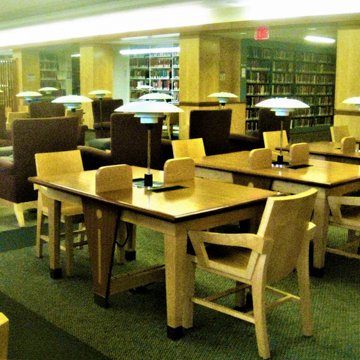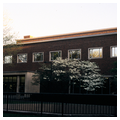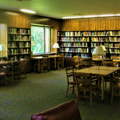Across Quincy Street, three specialized libraries anchor Harvard Yard's southeastern corner. Richard Dean of Perry, Shaw and Hepburn created Houghton Library (1941) as a repository for rare books; it represents the last major academic revival building constructed on campus before the American entry into World War II. Like the neighboring president's house by Guy Lowell, Houghton Library is Federal Revival—even Bulfinch Revival—in its fine classical detailing and bowfronted entrance facing Quincy Street. Elaborate wooden paneling enhances the interior spaces; a copper-covered bridge connecting Houghton to Widener Library (HY11) was removed in 2004. Nearby, Coolidge, Shepley, Bulfinch and Abbott designed Lamont Library (1947–1948), the first prominent modern building at Harvard. Boxy and unadorned, it nevertheless relates to its neighbors through the red brick and limestone of its exterior. Alvar Aalto designed a poetry room inside. Hugh Stubbins gained a reputation for remarkable discretion when he designed Pusey Library in 1973–1976. The home to the university archives and a theater collection, it is mostly underground, maintaining a corner of open space in front of Houghton and Lamont libraries and respecting an existing pedestrian path.
You are here
Harvard Yard Libraries
If SAH Archipedia has been useful to you, please consider supporting it.
SAH Archipedia tells the story of the United States through its buildings, landscapes, and cities. This freely available resource empowers the public with authoritative knowledge that deepens their understanding and appreciation of the built environment. But the Society of Architectural Historians, which created SAH Archipedia with University of Virginia Press, needs your support to maintain the high-caliber research, writing, photography, cartography, editing, design, and programming that make SAH Archipedia a trusted online resource available to all who value the history of place, heritage tourism, and learning.




































